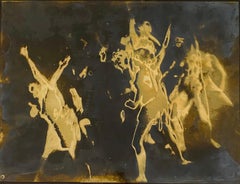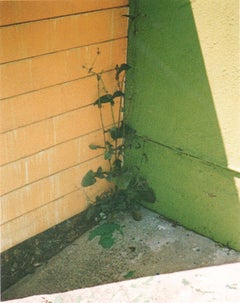Valentin Samarine started doing abstract painting in the 60s, and abstract photography in the 70s. He moved fairly easily from one to the other. It is in a perfectly logical sense: Valentin relies in both cases on a model of spontaneous creation, implemented in the post-war years in European painting, whether it is abstract expressionism (USA), action art (England) or tachism (France) .
Valentin Samarine methodically destroys, at all stages, the mechanistic function of the photographic process. In Leningrad, he had experimented and put a dose of unpredictability at the time of the shooting and during the development. In Paris, Valentin went from the negative to the process of revelation of the positive, by giving the "representation the maximum of possibilities for possible metamorphoses, without imposing anything on it, in particular with regard to the range of colors. the metatechnics of contact between the still invisible, floating or spinning jets, like sleds coming down from the mountain. " (V. Samarine)
This deeply respectful, almost religious attitude towards the process of creation and all its components allows the artist to approach the limits of three-dimensional space, beyond which vibrate the parapsychological, transpersonal and metaphysical dimensions. Insofar as metareality is unlikely to resemble that constantly returned to us by mainstream cinema, with its zoo- or anthropomorphic beings and its technical aggregates, the work of Valentin Samarine is, in a way or another, entirely non-figurative and abstract.
Valentin Till Maria Samarine-Smirnov (1928) is a representative of Leningrad underground culture, immigrated to France in the early 1980s. His solo photo exhibition Sanki Magic was held in the Moscow Museum of Modern Art.
Valentin Samarine was an active participant of the cultural and political life in Leningrad. In 1978, the photographer organized Studio 974, an art gallery in his own apartment. The studio hosted regular exhibitions of Leningrad artists and photographers. An atmosphere of total democracy reigned there.
Samarine’s art recorded the key cultural events of the epoch. His photos depicted such significant events, as Andrey Tarkovsky’s burial service in Alexander Nevsky Cathedral, Joseph Brodsky’s performances, cross procession in St. Sergey Metochion. Inspired by Choreographic Miniatures by Leonid Yakobson, the photographer was keen on ballet. He took pictures of many theater and ballet performances. But soon, through the pressure of the Soviet authorities, the photographer had to immigrate to France, where he continued his photo experiments.
Samarine called his oeuvre Sanki Art. It was a special technique of the new old silver-based photography. Sanki is an ordnance of the old silver-based photography, metamorphoses of energy projections, invisible in the ordinary photo, metaphysics of invisible projections of the Light and the Shadow of the spiritual world of a person, his passions, said the author. The word Sanki was adopted from Sense energetics, a book about Ancient Chinese philosophy. The notion reveals invisible energy potentials of Time and Space, which determine our earthly existence. This special technique enables the master to display the things that are hidden from the viewers in the ordinary photos.
Artworks by Samarine are in the collections of Moscow Museum of Modern Art; the Russian Museum; Yaroslavl Art Museum; the Museum of Non-Conformist Art, St-Petersburg; the State Museum of
Urban Sculpture...




